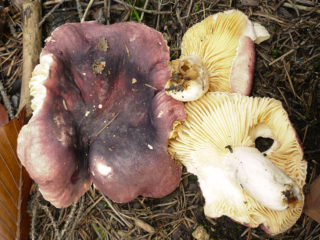Content
Trihaptum brown-violet belongs to the Polyporaceae family. The main distinguishing feature of this species is its unusual hymenophore, consisting of radially arranged plates with jagged edges. This article will help you get to know Trihaptum brown-violet closer, learn about its edibility, places of growth and distinctive features.
What does trihaptum brown-violet look like?

In some cases, the brown-violet trichaptum acquires a greenish tint due to epiphytic algae that have settled on it
The fruiting body is half-shaped, sessile, with a tapering or wide base. As a rule, it has a prostrate shape with more or less bent edges. Does not differ in large sizes. So, the caps are no more than 5 cm in diameter, 1-3 mm in thickness and 1.5 mm in width. The surface is velvety to the touch, short-felt, white-grayish in tone. The edges of the cap are bent, sharp, thin, in young specimens they have a lilac tint, turning brown with age.
The spores are cylindrical, smooth, slightly pointed and tapered at one end. White spore powder. The hyphae of the hymenophore are characterized as hyaline, thick-walled, weakly branched with a basal buckle. Trama hyphae are thin-walled, thickness is no more than 4 microns.
On the inside of the cap there are small plates with uneven and brittle edges, which later resemble flat teeth. At the initial stage of ripening, the fruiting body is purple in color and gradually acquires brown shades. The maximum fabric thickness is 1mm and becomes stiff and dry when dried.
Where and how does it grow
Trihaptum brown-violet is an annual mushroom. Mainly located in pine forests. Found on coniferous wood (pine, fir, spruce). Active fruiting occurs from May to November, but some specimens can exist throughout the year. Prefers a temperate climate. On Russian territory, this species is located from the European part to the Far East. Also found in Europe, North America and Asia.
Is the mushroom edible or not?
Trihaptum brown-violet is inedible. It does not contain toxic substances, but due to its thin and hard fruiting bodies it is not suitable for use as food.
Doubles and their differences

Located on wood, trihaptum brown-violet causes white rot
The most similar types of brown-violet trihaptum are the following specimens:
- Trihaptum larch – an annual tinder fungus; in rare cases, biennial fruits are found. The main distinguishing feature is the hymenophore, consisting of wide plates. Also, the caps of the double are painted in a grayish tone and have the shape of a shell. The favorite place is dead larch, which is why it received its corresponding name. Despite this, this species can be found on large dead trees of other conifers. This lookalike is considered inedible and is quite rare in Russia.
- Trihaptum spruce - an inedible mushroom that grows in the same area as the species in question. The hat has a semicircular or fan-shaped shape, painted in gray tones with purple edges. The double can only be distinguished by its hymenophore. In spruce it is tubular with 2 or 3 angular pores, which subsequently resembles blunt teeth. Trihaptum spruce grows exclusively on dead wood, mainly spruce.
- Trihaptum ambiguus – grows on deciduous wood, prefers birch. Not found on coniferous deadwood.
Conclusion
Trihaptum brown-violet is a tinder fungus that is widespread not only in Russia, but also abroad. Since this species prefers a temperate climate, it grows extremely rarely in tropical regions.











